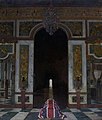The Signing of Peace in the Hall of Mirrors
This article includes a list of references, related reading or external links, but its sources remain unclear because it lacks inline citations. (September 2020) |

The Signing of Peace in the Hall of Mirrors, Versailles, 28 June 1919 is an oil-on-canvas painting by Irish artist William Orpen, completed in 1919. It was one of the paintings commissioned from Orpen to commemorate the Peace Conference at Versailles in 1919. The work is held by the Imperial War Museum in London.
Background[]
Orpen was one of the first people chosen as a war artist by the British Ministry of Information in 1917. Orpen was also the official painter at the peace conference and was commissioned to paint three canvases to record the proceedings. The work was the most expensive of the British public art commissions associated with the First World War: Orpen was paid £3,000; by comparison, John Singer Sargent received £300 for his much larger painting Gassed.
The painting depicts the signature of the Treaty of Versailles by representatives from Germany on 28 June 1919 that formally ended the First World War. The group portrait depicts soldiers, diplomats and politicians who attended the conference while the treaty was signed in the opulent surroundings of Louis XIV's Hall of Mirrors at the Palace of Versailles. High up can be seen the words "Le Roy Gouverne par lui meme" (French: "The King governs alone"). It measures 152.4 × 127 centimetres (60.0 × 50.0 in).
Orpen grew to dislike the politicians at the conference and considered them vain and greedy. In his painting, they are dwarfed by the scale of the palace.
Subjects[]
The people depicted are:
In the front row:
- Johannes Bell, German Centre Party politician, Reichskolonialminister (Minister of Colonial Affairs) and Reichsverkehrsminister (Minister of Transport), sitting in a chair, signing the treaty
- Hermann Müller, German SPD politician and Reichsaußenminister (Foreign Minister), stands beside him, leaning over
Seated in the middle row, from left to right:
- General Tasker H. Bliss, US Army officer and former Chief of Staff of the United States Army, in army uniform
- Edward M. House, US adviser to Woodrow Wilson
- Henry White, US diplomat and former US Ambassador to Italy and to France
- Robert Lansing, US Secretary of State
- Woodrow Wilson, President of the United States, holding papers
- Georges Clemenceau, Prime Minister of France
- David Lloyd George, British Prime Minister
- Bonar Law, British Lord Privy Seal (and later Prime Minister)
- Arthur Balfour, British Secretary of State for Foreign Affairs and former British Prime Minister
- Alfred Milner, 1st Viscount Milner, British Secretary of State for the Colonies
- George Barnes, British Minister Without Portfolio representing Organised Labour
- Marquis Saionji Kinmochi, genrō and former Prime Minister of Japan
Standing in the back row, from left to right
- Eleftherios Venizelos, Prime Minister of Greece
- Afonso Costa, former Prime Minister of Portugal
- Sir George Riddell, British journalist
- Sir George Foster, Canadian MP and delegate
- Nikola Pašić, former Prime Minister of Serbia and Prime Minister of Yugoslavia, with long white beard
- Stéphen Pichon, French Minister of Foreign Affairs, resting on a pillar
- Colonel Sir Maurice Hankey, British civil servant and first Cabinet Secretary, leaning over behind Clemenceau
- Edwin Montagu, British Secretary of State for India, behind the Maharajah of Bikaner
- Ganga Singh, Maharajah of Bikaner, from India, one of only two non-white members of the Imperial War Cabinet, leaning against a pillar
- Vittorio Emanuele Orlando, former Prime Minister of Italy
- Paul Hymans, Belgian Minister for Foreign Affairs
- General Louis Botha, Prime Minister of South Africa
- Billy Hughes, Prime Minister of Australia
Orpen is depicted twice, as an indistinct figure visible in the distorting mirrors behind the main subjects.
Other paintings[]
Orpen's other paintings of the conference depict preliminary discussions of the "Council of Ten" in the Hall of Clocks at the French Ministry of Foreign Affairs at the Quai d'Orsay, and another showing a coffin lying in state in a marble hall covered by a Union Flag.
External links[]
- The Signing of Peace in the Hall of Mirrors, Versailles, 28th June 1919, Imperial War Museum
- Art from Different Fronts of World War One, Roger Tolson, BBC History
- A Peace Conference at the Quai d'Orsay, Imperial War Museum
- Painting the Paris Peace Conference : William Orpen, 24 January 2009
- The Treaty of Versailles, 1919: A Primary Source Examination of the Treaty that Ended World War I, Corona Brezina, The Rosen Publishing Group, 2005, ISBN 1404204423, p. 31
- Breaking the Heart of the World: Woodrow Wilson and the Fight for the League of Nations, John Milton Cooper, Cambridge University Press, 2001, ISBN 0521807867, p. 412
- 1919 paintings
- War paintings
- Treaty of Versailles
- Paintings in the collection of the Imperial War Museum
- Paintings by William Orpen
- Group portraits
- Palace of Versailles
- Portraits of politicians

